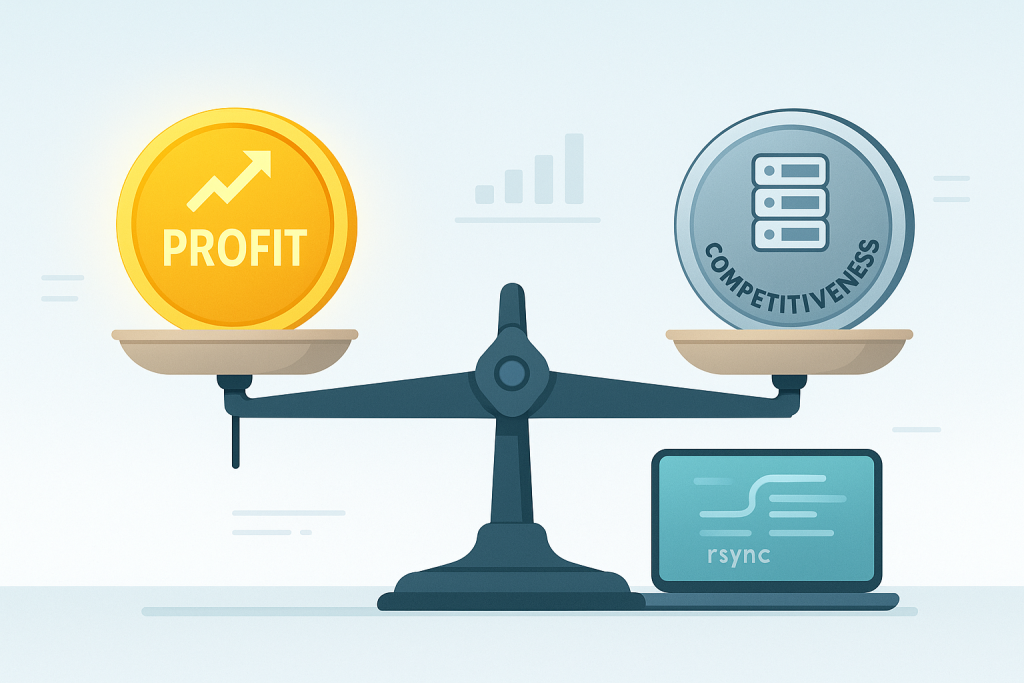The Ultimate Guide to Finding Your Reseller Hosting Sweet Spot
The reseller hosting business is a double-edged sword. On one side, it offers an incredible low-barrier entry into the world of web hosting with minimal technical overhead. On the other, you are instantly competing against giants who operate at a massive scale and can afford razor-thin margins.
If you charge too little, you’ll go broke dealing with high-maintenance, low-value clients. If you charge too much, your sales page will collect dust.
The secret to a successful reseller hosting business is finding the Pricing Sweet Spot: the magical price point where your plans are competitive enough to attract great clients and high enough to generate significant profit and fund top-tier service.
This guide will walk you through a step-by-step strategy to move beyond guesswork and set your prices with confidence, ensuring both profit and market competitiveness.
Step 1: The Non-Negotiable Foundation—Know Your True Costs (The Profit Floor)
Before you look at a single competitor’s price, you must understand your own expenses. This is your Profit Floor—the absolute minimum you can charge without losing money.
Your costs fall into three categories:
1. Direct Costs (Fixed Monthly)
This is the price you pay your parent hosting company.
- Your Main Reseller Plan: The monthly or annual fee for your wholesale hosting package.
- Billing Software: Licenses for tools like WHMCS, Blesta, or a similar automated billing and client management system.
Example Calculation:
If you pay $50/month for a Reseller Plan and $15/month for WHMCS:
Fixed Monthly Cost = $50 + $15 = $65
2. Operational Overhead (Fixed or Semi-Variable)
These are necessary costs for running the business, regardless of how many clients you have.
- Premium Tools/Licenses: Any extra licenses your clients might use (e.g., premium site builders, paid security scanners, specific backup services).
- Domain & SSL Costs: While you resell these, you pay a wholesale rate. Factor in the wholesale cost of a few “free” or discounted introductory domains and SSLs you might offer.
- Marketing & Website: The cost of your marketing tools, main reseller website domain, and theme/design costs.
- Support Costs: If you outsource or hire a dedicated support person, this is a major fixed cost. If you handle it yourself, factor in the monetary value of your time.
3. Variable/Per-Client Costs
These costs change based on the number of customers you have.
- Payment Processing Fees: Credit card processors (Stripe, PayPal) take a percentage and a fixed amount per transaction (e.g., $2.9% + $0.30$). This directly eats into your revenue.
- Excess Usage Fees: If your parent host charges you for going over resource limits (like extra bandwidth or storage blocks), you must account for this buffer.
The Break-Even Point Formula
To find your absolute minimum profitable price per client, you first need to calculate your Break-Even Point.
- Calculate Total Monthly Fixed Costs: Sum up all the fixed costs from categories 1 and 2. (Let’s assume our example total is $100/month).
- Estimate Max Client Count: Look at your main reseller plan and estimate how many accounts you can realistically host (e.g., 50 accounts).
- Calculate Cost Per Account:
- Raw Cost Per Account = Total Fixed Monthly Costs / Max Client Capacity
- Raw Cost Per Account} = $100/50 = $2.00
- Add a Buffer for Variable Costs & Profit Margin: You should aim for a minimum profit margin of 50-70% on the hosting component alone. This covers support time, churn, and unexpected fees.
Minimum Price = (Raw Cost Per Account + Variable Cost Buffer) x (1 + Desired Profit Margin)
Minimum Price} = ($2.00 + $0.50) x 1.50 = $3.75 (Absolute Minimum)
Never price below your Raw Cost Per Account, and ideally, never launch a plan below a 50% margin. Your break-even price is your floor.
Step 2: The Competitive Landscape—Determine the Market Ceiling
Once you know your floor, you need to understand the Market Ceiling—the highest price a customer is willing to pay before they simply choose a better-known competitor.
This requires deep competitor analysis.
1. Choose Your Battlefield (Target Niche)
You cannot compete with giants like HostGator or Bluehost on price and volume. You need to niche down. Your target audience dictates your potential price range.
| Target Niche | Pricing Strategy | Focus & Value |
| Web Designers/Agencies | High-end, premium, predictable. | Dedicated support, staging sites, white-label, priority resources. Clients will pay more for reliability and personal service. |
| Local Small Businesses (e.g., Hair Salons, Restaurants) | Mid-range, all-inclusive, simple. | Hands-on setup, included email, local SEO expertise, “done-for-you” feel. |
| Personal Blogs/Students | Low-end, entry-level, minimal margin. | Fast, basic resources, cheap domain registration. Often high churn; best used as a lead-in. |
The Competitive Tiers to Analyze:
- The Budget Giants: The large, corporate hosts (e.g., GoDaddy, Bluehost). Check their renewal prices, not just the cheap introductory offers. This sets the low-end benchmark.
- Other Niche Resellers: Find other small, independent resellers targeting your specific audience (e.g., “Hosting for WordPress Agencies”). This is your direct competition and sets the most relevant price range.
- Managed WordPress Hosts: If you offer high-value, hands-on service, compare your premium plan to managed hosts (like Kinsta or WP Engine). This helps justify a high-end, value-based price.
2. The Feature-Price Comparison
Create a simple spreadsheet to compare three competitors against your proposed plans. Don’t just look at the price; look at the Value-to-Price Ratio.
| Feature | Competitor A ($/mo) | Competitor B ($/mo) | Your Proposed Plan ($/mo) |
| Disk Space | 20 GB SSD | Unlimited | 30 GB NVMe SSD |
| Bandwidth | Unmetered | 1 TB | Unmetered |
| Freebies Included | Free SSL, 1 domain | Free SSL, Backups | Free SSL, Daily Backups, Malware Scan |
| Unique USP | None listed | 24/7/365 chat support | Personal Setup & Migration Service |
| Price (Monthly) | $9.99 | $12.00 | $14.99 |
If your plan is $14.99, but you offer significantly faster storage (NVMe vs. SSD) and superior hands-on service, the higher price is justified. You are selling peace of mind, not just disk space.
Step 3: Structuring Your Plans for Profit and Conversion
Simply listing a single price is a guaranteed way to lose sales. You need a tiered structure that guides the customer to the most profitable choice for your business.
1. The Three-Tier Magic Rule (and the Decoy)
Always offer at least three plans:
| Plan Name | Purpose | Psychology | Pricing Style |
| Tier 1: Starter/Basic | The Attraction plan. Low price to get people in the door. | Anchoring Effect: Makes other plans look better. | Lean, just above your profit floor. |
| Tier 2: Business/Pro | The Target plan. The one you want everyone to buy. | Center Stage Effect: People gravitate to the middle option. | Highest profit margin, best feature mix. Make this your default selection. |
| Tier 3: Premium/Agency | The Decoy and High-Value plan. | Value Anchoring: Makes the Pro plan look like a bargain. | High price point, including truly premium (and high-margin) features like priority support and staging. |
The Decoy Example:
- Basic: $4.99/mo (Too limited)
- Pro (Target): $12.99/mo (Best value for money) <– Most Popular Badge
- Agency (Decoy): $29.99/mo (Seems too expensive, but makes the $12.99 plan look cheap in comparison).
2. Implement Psychological Pricing Tactics
The way you display the price can be as important as the number itself.
- Charm Pricing: Always end in a ‘9’. Customers focus on the first digit, making $9.99 feel significantly cheaper than $10.00.
- Anchoring: Always list the most expensive plan first or show the “regular” price next to the discounted annual price. ($15/mo billed monthly vs. $10/mo billed annually). The $15 acts as the anchor, making the $10 look like an incredible saving.
- Value Fragmentation: Break down annual prices into a monthly cost. Instead of “$120 Annually,” say “$10/month (Billed Annually).” $10 feels much smaller and less of a commitment than $120.
- Show Savings: Clearly state the saving for choosing a longer term: “Save 33% by choosing our annual plan!”
Step 4: Maximizing Profit with Value-Added Bundles (The Upsell Matrix)
Hosting alone is a low-margin business. The true secret to reseller profitability is selling high-margin, value-added services with the hosting. This increases your Average Revenue Per User (ARPU) without having to find a new client.
Think of hosting as the coffee—and the add-ons as the profitable syrup shots.
| Add-on Service | Value to Client | High Margin? | Pricing Strategy |
| Daily Remote Backups | Peace of mind, quick recovery. | Yes. You set up the tool once. | Monthly subscription fee ($2–$5/mo) or included in the highest tier. |
| Premium Security Package | Proactive malware scanning, WAF (Web Application Firewall) rules. | Yes. Minimal management time. | Premium monthly fee ($3–$7/mo). Essential for e-commerce. |
| Website Maintenance/Care Plan | Updates, uptime checks, small content edits. | YES! This is recurring service revenue. | Separate high-value service ($50–$150/mo). Target designers/agencies. |
| Pro Email Hosting (G Suite/Microsoft 365) | Professionalism, large mailboxes. | Yes. You are the easy-access middleman. | Resell at a healthy markup over wholesale cost. |
| Priority Support | Guaranteed faster response times. | Yes. Limits high-maintenance clients to your top tier. | Included in the Pro/Premium tiers only. |
How to Implement Bundling:
- Default Bundle: Make sure your Target Plan (Tier 2) automatically includes 1-2 essential upsells (e.g., Daily Backups) to justify its higher price point over the Starter plan.
- Optional Checkboxes: On the checkout page, clearly list high-margin add-ons as options. Frame them as essential protection or professional necessities, not just extras.
- “Done-For-You” Service: For your premium clients (agencies/SMBs), don’t sell them hosting. Sell them “Managed Website Infrastructure” for a single, high monthly fee that includes hosting, backups, updates, security, and a certain amount of support time. This is the highest-margin approach.
Step 5: Renewal Strategy—The Key to Long-Term Profit
Many resellers offer a steep discount for the first year (e.g., 50% off) to acquire a customer, only to hit them with a massive price hike on renewal. This is a churn generator.
A more sustainable strategy focuses on predictable, value-based renewals.
1. Manage the Introductory Discount
- Keep it Modest: A 10-20% introductory discount for annual payment is fair. Avoid 75% or 90% off deals, as these attract clients who will only leave when the cheap period ends.
- Discount the Term, Not the Price: Instead of “50% off,” phrase it as “Get Your First 3 Months Free on any annual plan.” This anchors the customer to the full, stable price.
2. Justify the Renewal Price
The best way to reduce churn is to make clients feel like they are getting more value every year.
- Offer Loyalty Rewards: Give long-term clients a free upgrade to a faster server, a free domain renewal, or an extra security feature (like a free dedicated IP) upon their 2nd or 3rd renewal. This builds loyalty and justifies the full price.
- Proactive Communication: 60 days before renewal, email the client highlighting all the value they received in the last year: “You had 99.99% uptime, we performed 32 daily backups, and your site’s security was updated 4 times.” Remind them what they are paying for—not just a server, but a service.
- Raise Prices Responsibly: If you need to raise prices for current customers, announce it with new, superior features that come with the price increase (e.g., “Starting next month, all Pro accounts will receive NVMe storage and daily remote backups, necessitating a small price adjustment”).
The Bottom Line: Your Price Reflects Your Service
In the end, your pricing strategy is a statement about your brand.
- If you are the cheapest: You are competing on cost. You will have high volume, low margins, and high-maintenance, low-loyalty clients.
- If you are priced in the mid-to-high range: You are competing on value and service. Your prices must be genuinely competitive, but they must also clearly cover the cost of you. You are selling a relationship, personal support, and expertise that the massive corporate hosts simply cannot offer.
Focus on the right customers, calculate your true costs, set profitable tiers, and consistently over-deliver on service. That is the recipe for a competitive and profitable reseller hosting business.



